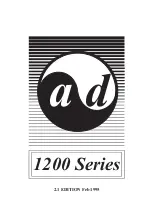
AD1200 Reference
Introduction
levels of illumination. This is not so with computers.
A computer uses numbers to represent physical quantities,
storing the values using bit patterns. Each bit in a computer’s
memory is either off or on, it cannot be half way on or nearly
on. If we are to store the value of light intensity on a computer
there must be some method of turning the smoothly varying real
signal value into a bit pattern in the computers memory. This
process is called analogue to digital conversion.
If only one bit is to be used to represent the light intensity
then the illumination would be divided into either on or off.
From total darkness to half light would be off, half light to full
illumination would be on. One bit gives two illumination states.
In general terms, resolution means separation into components.
The resolution of a converter is the smallest interval measurable
by the converter and this one bit converter’s resolution is 50%
of the signal.
Figure 1-4. One Bit A/D Conversion.
________________________________
ÚÄÄÄÄÄÄÄÄÄÄÄÄÄÂÄÄÄÄÄÄÄÄÄÄÄÄÄÄÄÄÄÄÄÄ¿
³
BIT PATTERN
³
ILLUMINATION LEVEL
³
ÃÄÄÄÄÄÄÄÄÄÄÄÄÄÅÄÄÄÄÄÄÄÄÄÄÄÄÄÄÄÄÄÄÄÄ´
³
1
³
ON
³
³
0
³
OFF
³
ÀÄÄÄÄÄÄÄÄÄÄÄÄÄÁÄÄÄÄÄÄÄÄÄÄÄÄÄÄÄÄÄÄÄÄÙ
If two bits of computer memory are used to represent the
light intensity then the illumination would be divided into off,
dark grey, light grey and full illumination. Two bits gives four
illumination states.
Figure 1-5. Two Bit A/D Conversion.
________________________________
ÚÄÄÄÄÄÄÄÄÄÄÄÄÄÂÄÄÄÄÄÄÄÄÄÄÄÄÄÄÄÄÄÄÄÄ¿
³
BIT PATTERN
³
ILLUMINATION LEVEL
³
ÃÄÄÄÄÄÄÄÄÄÄÄÄÄÅÄÄÄÄÄÄÄÄÄÄÄÄÄÄÄÄÄÄÄÄ´
³
11
³
ON
³
³
10
³
LIGHT GREY
³
³
01
³
DARK GREY
³
³
00
³
OFF
³
ÀÄÄÄÄÄÄÄÄÄÄÄÄÄÁÄÄÄÄÄÄÄÄÄÄÄÄÄÄÄÄÄÄÄÄÙ
With each increase in the number of bits used to represent
Page 6
Chapter 1
















































